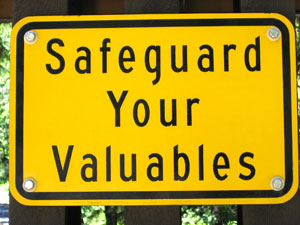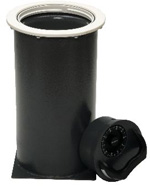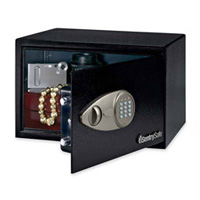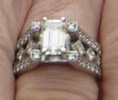Preventing jewelry losses
 People value their jewelry, often for sentimental as well as monetary reasons. But over time they may come to take it for granted, forgetting how vulnerable jewelry actually can be.
People value their jewelry, often for sentimental as well as monetary reasons. But over time they may come to take it for granted, forgetting how vulnerable jewelry actually can be.
Both insurers and jewelry owners are interested in preventing losses. Here are some tips for agents to pass on to clients for keeping their jewelry safe, and some suggestions for insurance personnel in preparing for and dealing with jewelry losses.
Avoiding Damage
Jewelry is more easily damaged than you might think. Harm can come both from impact and from exposure to chemicals.
- Remove your jewelry when playing sports, working in the garden, engaging in manual labor, using power tools, working on the car, or doing any activity where the jewelry could be bumped, chipped, broken, discolored or otherwise damaged.
- Avoid wearing jewelry while you’re using cleaning products and solvents or when handling outdoor chemicals such as fertilizers and insecticides. Some gems and metals can be damaged even by such common household products as bleach, vinegar and lemon juice.
- Chlorinated water can react with the metals found in jewelry, causing color changes and even structural damage. It’s best to remove jewelry before entering the pool or spa or when servicing swimming pools or hot tubs.
- Cosmetics, hairspray, perfumes and lotions may contain chemicals that can damage jewelry. Putting jewelry on after applying these materials will limit the jewelry’s exposure to damage.
- Do not leave jewelry lying on tables, dresser tops, or counters where it could be bumped unnoticed, fall into the garbage disposal, or otherwise disappear or be harmed. Avoid putting jewelry in a pocket, where you might forget about it.
- Prongs that hold gemstones in place in their mounting are prone to wear and can be easily repaired before a stone is lost. Many jewelers provide cleaning and inspection as a free service, so take advantage of it.
- Ultrasonic cleaners are machines that emit vibrations to loosen dirt from the jewelry. Steam cleaners loosen dirt using steam. Such machines for cleaning jewelry are available on the Internet for as little as $15, but using them is not always a good idea. Some gems can be damaged from vibration or steam. Do not use such a machine unless your jeweler/appraiser specifically says it will not cause damage to your jewelry.
- If you have specific questions about caring for your jewelry, ask your jeweler or appraiser.
Deterring Theft
Jewelry theft is often a crime of opportunity. Thieves look for the easiest targets, so every precaution you take can make a difference.
- Deadbolts on all outside doors and locks on all windows are a must.
- Don’t leave jewelry on dressers or counters. Workers and visitors in your home can be tempted by valuables that are visible or easily accessible.
- When jewelry isn’t being worn, store it in a vault, a home safe, or in a secure hiding place. The safe should be in-wall or in-floor or secured to the floor. A strongbox, often marketed as a personal jewelry safe, is not adequate since a burglar can simply carry it away and open it at his leisure.

Wall Safe Keeps jewelry secure |

Stongbox Can be carried away |
- If a safe is not available, store jewelry in a secure hiding place that is not in the bedroom, because the bedroom is the first place a burglar will look. Choose a place that is easily accessible to you but not obvious to an outsider.
- If you are away from home, be sure your house looks like somebody might be home. Don't let newspapers and mail pile up. Consider putting lights or TV on a timer to create the appearance that someone is home.
- When wearing jewelry outdoors, be aware of your surroundings. Flashy jewelry is a magnet for theft, and large crowds are a good cover for pickpockets.
- Earrings and necklaces can get caught in scarves, bracelets can be pulled off along with a glove. You can lose such jewelry without being aware of it.
- When traveling, keep your jewelry with you. Don't store it in luggage that will be handled by others and be out of your sight for extended periods. In hotels, store jewelry you aren't wearing in the hotel safe or in a room safe.
- Before traveling, make a list of the jewelry you'll be taking with you, keeping one copy with you and leaving one at home.
  Photos of jewelry taken by client |
- Have photos of all your jewelry. In case of loss, they will be useful to the insurer in settling your claim.
FOR AGENTS & UNDERWRITERS
Have photo(s) on file for each piece of scheduled jewelry. An agent's or client's photo of the jewelry is the best evidence that the jewelry exists and is in the policyholder's possession. In the event of a loss, a photo can be invaluable in showing how the jewelry looked and in pricing a replacement.
You can make photographing the jewelry a normal part of writing the policy, as it takes only a few moments. A small setup with digital camera (turn MACRO ON) and lighting (turn FLASH OFF) will suffice. Often the client in your office is wearing the jewelry, especially with engagement rings and wedding sets.
A remark of admiration for the jewelry goes a long way in customer relations. And a little time spent photographing the jewelry will impress the client with your thoroughness and attention.
Recommend that your clients get an appraisal from a trained gemologist (GG, FGA+, or equivalent), preferably one who has additional insurance appraisal training. One course offering such additional training is the Certified Insurance Appraiser™ (CIA) course of the Jewelry Insurance Appraisal Institute.
FOR ADJUSTERS
Make use of the jewelry’s pictures when pricing a replacement. They may reveal details that are not on the appraisal.
A photograph, even a poor one, may show that a lost piece of jewelry can be duplicated. This will probably be much less costly than paying the full limit of liability, especially considering the inflated nature of most appraisals.
On a damage claim for high-priced jewelry, always have the jewelry examined in a gem lab by a trained gemologist (GG, FGA+ or equivalent), preferably one who has additional insurance appraisal training, such as a Certified Insurance Appraiser™. The exam:
- will identify the gem;
- will verify the quality of the jewelry;
- may supply information missing from the appraisal;
- may reveal that the "damage" is not damage at all. An apparent chip may be a previously existing flaw (called an “indented natural”); or a change in the gem’s appearance may be the result of a gem treatment failure, such as the breakdown of fracture-filling material.
For a lab inspection, give the entire item to the lab. DO NOT tell the lab any details about the policyholder, or give out any documents on file, or discuss how the damage occurred. Ask for a complete description of the jewelry on a JISO 18 form. Ask the lab to estimate the cost of repair, to help you determine whether to repair the item or replace it. Do not commit to hiring this lab to do the repair.
If the cost of repair is so high that you choose to replace the item, use the information on the JISO 18 form to price a replacement. Shop around for the lowest bid. Do the same for salvage—shop it around.
If you have any suspicion that damage may be due to wear and tear or inherent vice, it may be worthwhile to consult a jewelry insurance expert.
©2000-2025, JCRS Inland Marine Solutions, Inc. All Rights Reserved. www.jcrs.com

